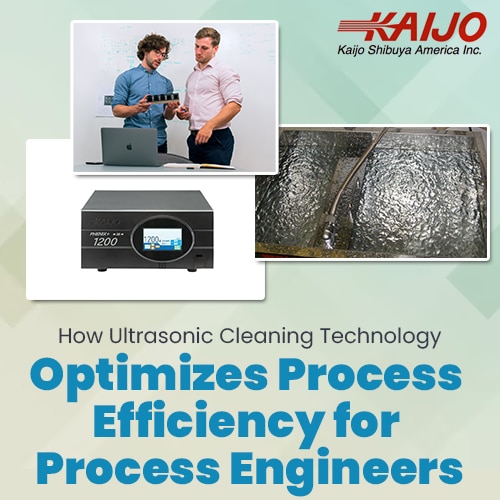How Ultrasonic Cleaning Technology Optimizes Process Efficiency for Process Engineers
September 19, 2023
 The effective and efficient cleaning of manufactured parts represents a significant challenge in industrial processes where output quality depends on part cleanliness. Traditional cleaning methods such as manual scraping and scrubbing, soaking in chemicals, or pressure washing are expensive and time-consuming. Workers may injure themselves using sharp or pointed tools. Exposure to chemicals can be hazardous. Dealing with these issues takes time away from making operations more efficient and cost-effective.
The effective and efficient cleaning of manufactured parts represents a significant challenge in industrial processes where output quality depends on part cleanliness. Traditional cleaning methods such as manual scraping and scrubbing, soaking in chemicals, or pressure washing are expensive and time-consuming. Workers may injure themselves using sharp or pointed tools. Exposure to chemicals can be hazardous. Dealing with these issues takes time away from making operations more efficient and cost-effective.
Ultrasonic cleaning is highly effective and works more quickly than traditional cleaning methods. Pre-soaking or manual cleaning of heavy contaminants is not required. Ultrasonic cleaning works with plain water and mild detergents rather than aggressive chemicals. When ultrasonic cleaning removes the challenges presented by traditional cleaning methods, engineers can focus on the process.
Understanding Ultrasonic Cleaning Technology
The key to understanding ultrasonic cleaning technology is that it relies on mechanical cleaning action at a microscopic level. The technology creates tiny cavitation bubbles in the cleaning solution. The bubbles form and collapse rapidly, in tune with the ultrasonic frequency. When the bubbles collapse, they emit small but powerful jets of cleaning solution that dislodge contaminating particles from the surfaces of the parts to be cleaned. Cleaning takes place rapidly and completely.
In contrast to traditional cleaning methods, ultrasonic cleaning works without harsh chemicals and cleans even hard-to-reach places. As a result, no manual cleaning is required before or after the automatic cleaning process. As long as the frequency and power are selected correctly, ultrasonic cleaning will clean down to the original surface of the parts to be cleaned in as little as ten minutes.
How Ultrasonic Cleaning Enhances Process Efficiency
Increased process efficiency with ultrasonic cleaning results from faster cleaning times and more complete cleaning. When cleaning cycle times are reduced, overall process throughput can increase. Consistent and thorough cleaning results can improve output quality and reduce the number of defective components produced: reduced manual labor and the elimination of expensive chemicals lower costs. When parts are completely clean after preventive maintenance, facility downtime is less. All these factors help process engineers achieve a more efficient operation.
Applications of Ultrasonic Cleaning in Process Engineering
As the benefits become clear, more industrial processes are being changed to incorporate ultrasonic cleaning technology. Semiconductor manufacturing uses ultrasonic cleaners to clean silicon wafers. Automotive manufacturers and restoration facilities use ultrasonic technology to clean automotive components such as valves, transmission parts, differentials, and carburetors. Ultrasonic cleaners are used to clean electronic circuit boards, and medical devices are cleaned with ultrasonic cleaners before use. In each case, cleaning speed and performance were important reasons for the switch.
Overcoming Challenges with Ultrasonic Cleaning Technology
The versatility of industrial ultrasonic cleaners and the ability to customize them can help process engineers address process efficiency and quality challenges. Self-contained ultrasonic cleaners can be installed in the space previously reserved for part cleaning. Existing tanks can often be reused. The cleaners have no special installation requirements, and they are low maintenance. Switching to ultrasonic cleaning can speed up the production lines, and consistent cleaning can lead to improved production line performance.
Key Considerations for Process Engineers
From the process side, key factors affecting the ultrasonic cleaning process are the composition of the parts to be cleaned, the nature of the contaminants, and the compatibility of the cleaning solution. These factors influence the selection of a suitable ultrasonic cleaner. The right cleaning frequency, the power, and the type of cleaning solution must match the cleaning application. Once the ultrasonic cleaner is selected, cleaning times can be determined to obtain cleanliness according to industry or internal standards.
Kaijo Shibuya Can Help Make the Switch
As a leader in ultrasonic cleaning technology, Kaijo Shibuya can advise process engineers to optimize production line performance. Kaijo can help specify the ultrasonic cleaners that are required and offer products from its complete line of ultrasonic cleaning equipment. With new ultrasonic cleaners installed, process engineers can focus on defining the ideal degree of cleanliness and the types of cleaning solutions that best remove specific contaminants.
Contact Kaijo to discuss how ultrasonic cleaning can be used for your application. Kaijo offers free consultation and can present ultrasonic cleaning options that best fit a particular process. Once the ultrasonic system is selected, Kaijo can help with installation and setup. Based on extensive in-house expertise and experience, Kaijo helps ensure that the installed systems work as expected and deliver the anticipated benefits in increased efficiency and improved output quality.





